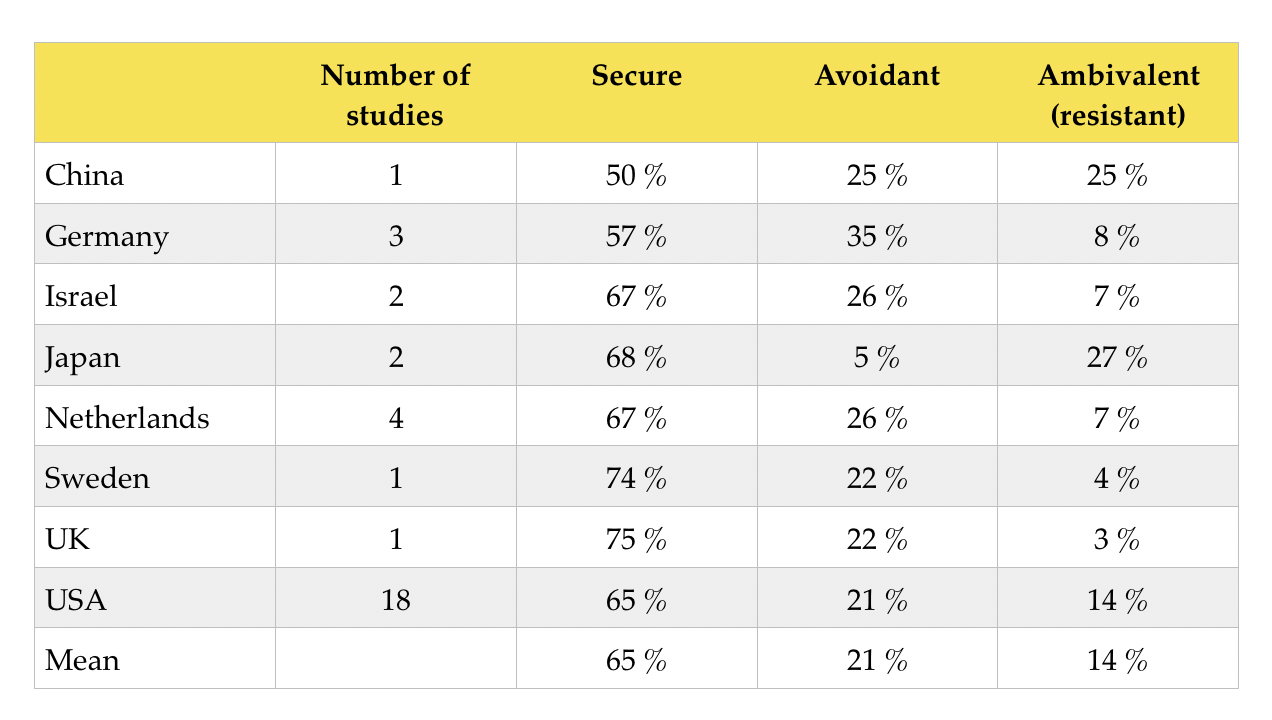Van Ijzendoor and Kroonenberg (1988)
 One of the key questions in psychology is the extent to which behaviour is universal. Researchers have noted that the way parents raise children is different around the world - but is the attachment between a child and their caregiver the same in all cultures?
One of the key questions in psychology is the extent to which behaviour is universal. Researchers have noted that the way parents raise children is different around the world - but is the attachment between a child and their caregiver the same in all cultures?
Van Ijzendoor and Kroonenberg (1988) wanted to see if the rate of secure attachment was universal. They did this by carrying out a meta-analysis of research using the strange situation test.
This study is appropriate for discussing sociocultural factors in attachment - or sociocultural factors in the study of developing an identity.
Mary Ainsworth developed the Strange Situation Test to observe individual differences between mother-child pairs in terms of the quality of their attachment relationships.
In the strange situation test, the mother and infant are first left alone in a room together. Then a stranger enters and the mother leaves. The mother then returns and the stranger leaves. The mother then leaves the baby completely alone. Then the stranger returns. Then the mother returns and the stranger leaves.
Based on her observations during the strange situation test, Ainsworth classified the children into three attachment groups.
Type A - Insecurely attached - avoidant (20 percent of the children) The child shows apparent indifference when the mother leaves the room, and avoids contact with her when she returns. The child is apparently not afraid of strangers. The mothers of type A children tend to be insensitive and do not seem interested in their child’s play.
Type B - Securely attached (70 percent of the children) The child is upset when the mother leaves and is happy to see her again. The child is easily comforted by the mother. The mothers of type B children are very interested in their child’s play and actively communicate with their children during play.
Type C - Insecurely attached - ambivalent (10 percent of the children) The child is very upset when the mother leaves the room, and she has difficulty soothing the child when she returns. The child seeks comfort, but at the same time rejects it. The mothers of type C children tend to be inconsistent in their reactions to the children.
Ainsworth argues that parenting styles may lead to variations in the level of each attachment style. These parenting styles are the result of environmental conditions and social norms.
Van Ijzendoor and Kroonenberg (1988) carried out a meta-analysis of 32 studies on attachment in eight countries, including 2000 infants. All studies used the strange situation test. The samples were from the USA, Great Britain, Germany, Netherlands, Sweden, Japan, China, and Israel.
The findings are in the chart below.

The researchers found that there was consistency in the overall distribution across all cultures. Secure was the most common in all eight cultures. There was some variation in the type of insecure attachment. In China, there was no difference between the two types, whereas, in Western countries, there was more avoidant behaviour than ambivalent (resistant) behaviour. Only in Japan was there more ambivalent (resistant) behaviour than avoidant. The researchers argue that there is greater variation within cultures than between cultures.
Although this study is a large study, including 2000 infants, the data taken from any one culture is limited. The majority of the research comes from individualistic cultures like the US, UK, and Germany. The study also only looks at developed countries. In addition, the samples were predominantly middle-class parents, meaning that there may be a bias which explains the lack of variation between cultures.
There are questions about the validity of the Strange Situation test. There are some that argue that it is ethnocentric, promoting an individualistic cultural dimension. Others have criticized the test for lacking ecological validity.
The sample of any one study is relatively small; therefore, we should be cautious in generalizing the findings to the entire culture.
Meta-analyses are open to researcher bias as the researcher selects research based on a set of criteria that are chosen by the researcher.
This study is done in 1988. As globalization has had an effect on parenting styles and family structure, this study may lack temporal validity.

 IB Docs (2) Team
IB Docs (2) Team
